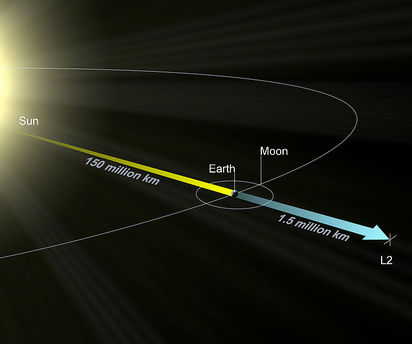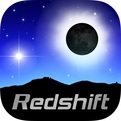Lagrangian points help to save fuel
Where is the best parking spot for a Satellite?
 © NASA
|
Lagrangian point L2 is located outside the Earth’s orbit. Here, the gravitational pull of the Earth and the Sun balance the centrifugal force of its own motion around the Sun. So satellites only need minimal amounts of fuel for minor orbital corrections.
Lagrangian points help to save fuel.
The two European space telescopes Herschel and Planck are scheduled to be launched in April 2009. Both satellites will have their own orbit around Lagrangian point L2. From this position, they will measure heat radiation in space. The L2 point is located outside the Earth’s orbit. Here, the gravitational pull of the Earth and the Sun balance the centrifugal force of its own motion around the Sun. Thus, Herschel and Planck will only need minimal amounts of fuel for carrying out minor orbital corrections while they are in this position.
Apart from saving fuel, 'parking spot' L2 offers other advantages: The antenna used to transmit data to Earth is always pointing in the right direction, and its transmission power does not need to be continually adjusted since the satellite's distance from the Earth remains constant. Thanks to the fact that space telescopes at L2 stay in the same position relative to the Sun and the Earth, it is also easier to shield them from the sunlight that would otherwise perturb their orbit.
Credit: German Aerospace Center
Lagrangian points help to save fuel
Where is the best parking spot for a Satellite?
 © NASA
|
Lagrangian point L2 is located outside the Earth’s orbit. Here, the gravitational pull of the Earth and the Sun balance the centrifugal force of its own motion around the Sun. So satellites only need minimal amounts of fuel for minor orbital corrections.
Lagrangian points help to save fuel.
The two European space telescopes Herschel and Planck are scheduled to be launched in April 2009. Both satellites will have their own orbit around Lagrangian point L2. From this position, they will measure heat radiation in space. The L2 point is located outside the Earth’s orbit. Here, the gravitational pull of the Earth and the Sun balance the centrifugal force of its own motion around the Sun. Thus, Herschel and Planck will only need minimal amounts of fuel for carrying out minor orbital corrections while they are in this position.
Apart from saving fuel, 'parking spot' L2 offers other advantages: The antenna used to transmit data to Earth is always pointing in the right direction, and its transmission power does not need to be continually adjusted since the satellite's distance from the Earth remains constant. Thanks to the fact that space telescopes at L2 stay in the same position relative to the Sun and the Earth, it is also easier to shield them from the sunlight that would otherwise perturb their orbit.
Credit: German Aerospace Center






